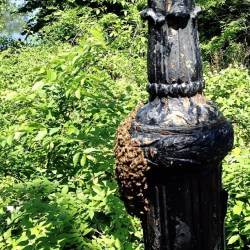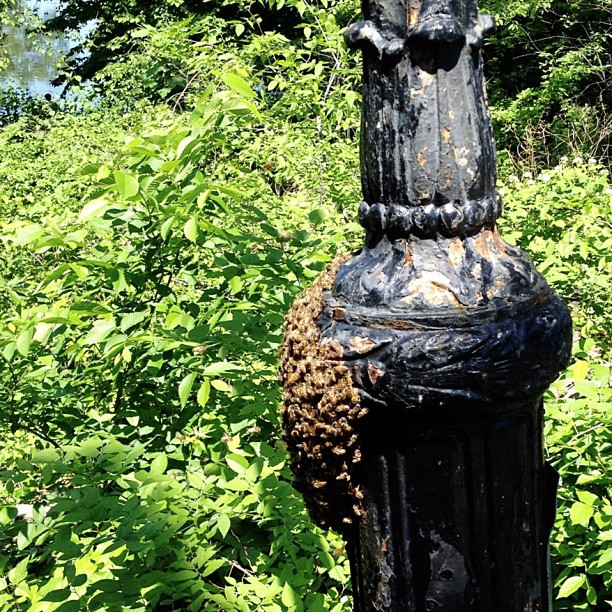
Bees swarm a light pole in Central Park.
On a rooftop a few dozen blocks south of my apartment, there’s a beehive. The hive’s owner, a woman named Susan, keeps what she described as an Italian species of bee, Carniolans. (In reality, the species is from Slovenia.) Pedigree aside (we are talking about the tony Upper West Side, after all), Carniolans have other traits to recommend them. They’re more docile, for example, and more resistant to certain diseases. They are also more prone to swarming.
This week, The New York Times reported that bee swarms are increasingly appearing around the city.
This spring in New York City, clumps of homeless bees have turned up, often in inconvenient public places, at nearly double the rate of past years. A warm winter followed by an early spring, experts say, has created optimal breeding conditions. That may have caught some beekeepers off guard, especially those who have taken up the practice in recent years.
There’s a link between hive overcrowding and swarming. When a hive becomes too crowded, bees can be displaced. New beekeepers, the Times suggests, can be unprepared to deal with a number of bees suddenly looking for a place to stay. The New York City real estate market is tough for everyone.
Bee swarms are frightening. Several weeks ago, my wife and I encountered one on a light pole in Central Park. An audible hum; a teeming mass orbited by a few stragglers. We did what anyone would do: took pictures, Instagrammed them, quickly moved on. (See above!)
James Fischer, director of education for NYC Beekeeping (the organization with which Susan also volunteers), suggests that such a reaction is unwarranted. “A swarm is as harmless as a cat up a tree,” he told me, “and just as newsworthy.”
Fischer isn’t convinced that the number of swarms has actually increased. Those mentioned by the Times have been reported elsewhere. My spotting notwithstanding, Fischer notes that those who participate in NYC Beekeeping’s free training sessions “haven’t seen any more swarms this year than last.” He notes that swarms only happen on sunny days, possibly meaning that sightings have been clustered together during a generally rainy spring.
If there are more swarms, though, it could be a good sign.
“This year, all the rules were broken,” said Dennis vanEngelsdorp, a researcher at the University of Maryland who helped to lead a national survey of managed honey bee colonies released this month. It showed that about 21.9 percent of bee colonies nationwide died over the winter, a substantial drop from the 30 percent average losses reported in the previous five years.
When asked if this meant a rebound in the population, Mr. vanEngelsdorp said on Skype from Pretoria, South Africa, “It’s too early to tell.”
A rebound would be welcome. Bee populations worldwide are collapsing. In North America and Europe, it’s partly due to an as-yet-unexplainable affliction known as colony collapse disorder. Here and elsewhere, there are other causes as-yet-unknown. The event* where I met Susan the beekeeper was the one I wrote about on Monday, the kick-off of Pollinator Week. Pollinator Week, a project of the Pollinator Partnership, is an effort to raise awareness about the issues impacting pollinators — bees, birds, bats — and what that means for our food supply. The week wraps up today.
In 2010, New York City lifted its ban on apiaries. The rules now are surprisingly lax, meaning that it’s up to organizations like NYC Beekeeping to continue to educate keepers and try to police behavior. From the Times:
“It’s up to beekeepers to practice swarm prevention techniques and regular hive maintenance,” said Andrew Coté, the president and founder of the New York City Beekeepers Association, adding that many beekeepers were “poor stewards” for not regularly inspecting their hives. “If they treated their dog or cat in the same way, they would be taken up on charges,” he said. …
Mr. Coté advocates stricter regulations. “But you can’t regulate common sense,” he added.
Any more than you can regulate the behavior of bees. Not that we shouldn’t try.
Learn more about how to encourage bee population growth.
* Here’s something I learned at the same event: a male carpenter bee is so docile as to be able to be caught in your hands. Males have yellow faces, so if a giant bee is flying toward you and it has a yellow face, feel free to grab it! You could probably even carry it in your mouth. Go ahead; try that.**
** Our lawyers have advised me to say that you should not do this.
Update: A reader noted that Carniolans are not an Italian species, but are native instead to Slovenia.




